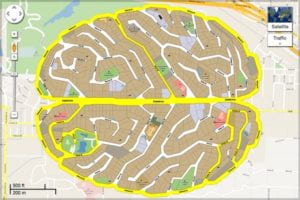“We are also the skin of what we wear. The garment being cut and sewn is not only for us to wear; the city also wears us.” Using such a metaphor, Bratton talked about the sentient city, and the mutual interaction between the urban AI technology and citizens. A driverless car is a common example for urban sensing, as we all know, it has multiple sensors to detect situations and form its behavior by algorithms. However, a driverless car is just a small part of the road, a tool to make life more convenient. And what Bratton suggested in his article is an incipient mechanic sensate world – the whole sensing and thinking systems are built into the fabric of the city. It’s interesting to read the author’s comparison between the cuttlefish and the sentient city. Based on material chemistry, the operating mechanism of the city is just like a cuttlefish, which can respond to different situations flexibly like the nervous system of the brain. However, some people also pointed out the potential risks of the sentient city in public health, national security and the environment. (Read more here)

A picture that compares the city to a brain system
Gabrys argued that telepathy is a form of invisible communication that can describe “how a wireless city talks to itself, circulating messages and programming urban ecologies.” (Pp. 50) Here the famous argument “The medium is the message” raised by McLuhan was applied to the urban telecommunication in a new way. The invisible particles in the atmosphere of urban city act as medium, and at the same time, they also make up the important electrical environment that change the people’s life. The author then talked about Paul Virilio’s discussion of the “overexposed city”, in which he pointed out that the electronic telecommunication changed the physical fabric of the city in both spatial and time dimensions. Here I found that his opinion was somehow similar to my thoughts about the mobile food delivery system. He said that, with telecommunications, the city exists all at once and so lacks “here and there”, and another assemblage of space and time emerges through the operation of invisible frequencies. Therefore, the modes of space and time are intensified, and electronic signals can transmit across stretches of space all the time.
When it comes to the Mobile food delivery system, I argue that it changes urban citizen’s understanding of space and time, and the invisible spatial and time infrastructures in the modern city. First, online ordering and delivery system have changed the standard by which people measure time. People’s estimation of time is largely shaped by the results generated by the platform’s big data and algorithms. The division of labor and the order-taking system continue to shorten the delivery time, thus intensifying such competition in the industry. Besides, the limited cold chain coverage prevents rural residents from buying foods with a short shelf life. Therefore, the difference in time perception between urban and rural residents can become more obvious. Secondly, the convenient mobile food delivery system makes the location of restaurants and food stores no longer important. Even if people often buy food from a restaurant, they may not know where some shops are located. Just as Virilio said, the virtual mirage of is presented in front of people with the help of digital technology, so people further reduce their attention to the street and physical location. Moreover, the rapid development of the mobile food industry has largely hit physical stores, leading to the emergence of some restaurants without physical storefronts, further aggravating the curl of urban space.
Leave a Reply